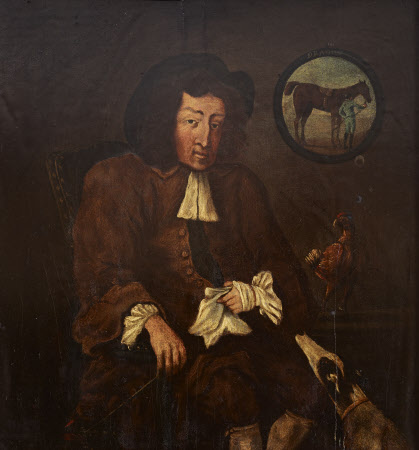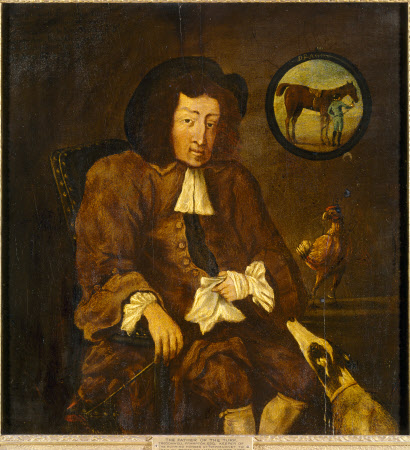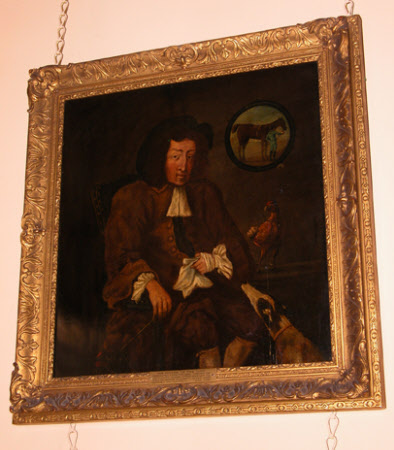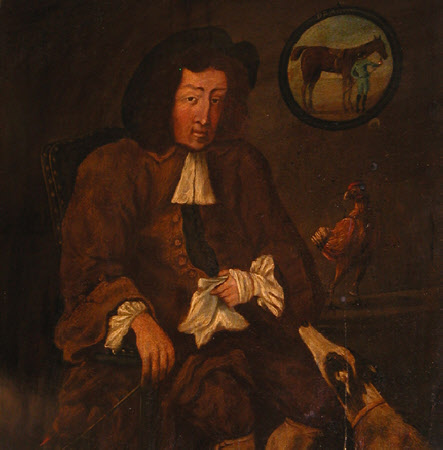Tregonwell Frampton, ‘Father of the Turf’ (1641-1727) (after John Wootton)
after John Wootton (Snitterfield c.1682 – London 1764)
Category
Art / Oil paintings
Date
1770 - 1799
Materials
Oil on canvas
Measurements
443 x 420 mm
Order this imageCollection
Anglesey Abbey, Cambridgeshire
NT 515502
Summary
Oil painting on canvas, Tregonwell Frampton, ‘Father of the Turf’ (1641-1727) (after John Wootton), British (English) School. Portrait of an elderly man, nearly-full-length, seated in a black arm-chair with gilt studs around the edges, turned three-quarters to the right, gazing at spectator. He wears a white shirt with only a simple linen cravat shown at the neck, full gathered sleeves shown at the wrist under a crumpled brown coat and brown knee-breeches, he also wears white stockings, and a tricorn hat. His left hand, which holds a linen handkerchief, is bandaged across the palm, in his right hand he holds a whip at his side. To the right, its head leaning on his left knee, is a greyhound, which looks up at him, a fighting cock stands on a table, on the right, beside him, and above it hanging on the wall is a circular painting of his racehorse Dragon.
Full description
Known in his lifetime as ‘Father of the English Turf’, Frampton was Keeper of the Running Horses at Newmarket and he may have been Charles II’s racing manager as well. For over thirty years he fulfilled the role of arbiter in racing disputes before the foundation of the Jockey Club. This painting, after the original by John Wootton shows him with his dog and fighting cock and with a portrait of his favourite horse Dragon, whom it was rumoured Frampton had gelded so that he could run him in a race with very high stakes. There are several versions of this popular subject; and the image was further popularized by engravings by Faber and others. The original was an unusual excursion into portraiture for Wootton, who normally restricted himself to sporting art, but should be seen in the context of Wootton's early Newmarket scenes. Frampton was born in Moreton, Dorset and from 1695 under William III he was appointed the royal trainer at Newmarket and remained in this post during the reigns of Queen Anne and the Georges I and II. (see History of the British Turf by J. Christie Whyte). History of England. Class XII. 'Persons Remarkable for one Circumstance only', p.387: Tregonwell Frampton, Royal Stud Keeper at Newmarket. ‘It has been said of this man that he was ‘a thorough good groom only, yet would have made a good minister of state, if he had been trained for it.’ Frampton was supposed to be better acquainted with the genealogy of the most celebrated horses than any man of his time; for he could reckon up sires, grandsires, great grandsires, and great great grandsires, which he had himself seen . . . It is sufficient to add, that Frampton could choose the best racers equally well, from the thorough English black, to the best bred bay; and that 'not a splint or sprain, or bad eye, or old broken knee, or pinched foot, or low heel, escaped in the choice of a horse.’ But the longest heat will come to an end; and even Frampton finished his course in 1727, aged 86.’ Newmarket: an Essay on the Turf, 1771: ‘This gentleman (whose picture may be seen in many a house in Newmarket) was as great an oddity as perhaps ever was heard of. He was a known woman hater . . . passionately fond of horse racing, cocking and coursing, remarkable for a peculiar uniformity in his dress, the fashion of which he never changed, and in which regardless of his uncouth appearance, he would not unfrequently go to court, and enquire in the most familiar manner for his master or mistress, the King or Queen. Queen Anne used to call him 'Governor Frampton.’
Provenance
Bequeathed to the National Trust by Huttleston Rogers Broughton, 1st Lord Fairhaven (1896-1966) with the house and the rest of the contents.
Credit line
Anglesey Abbey, The Fairhaven Collection (National Trust)
Makers and roles
after John Wootton (Snitterfield c.1682 – London 1764), artist British (English) School, artist



